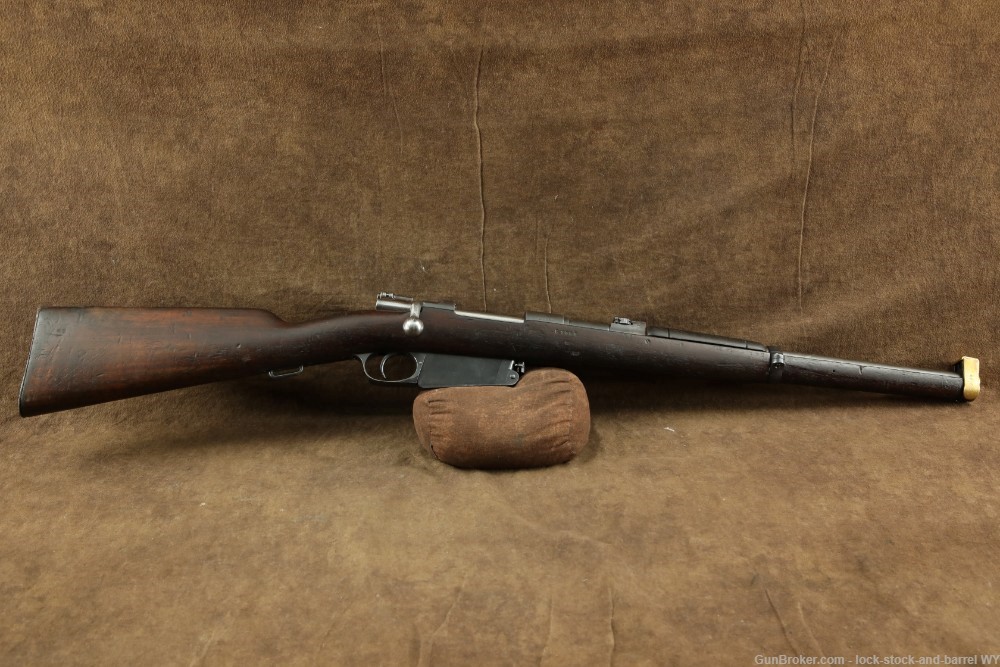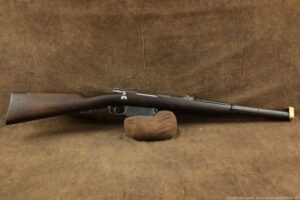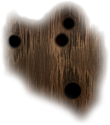
Argentine Mauser 1891 Cavalry Carbine DWM 7.65×53 Matching Bolt Action C&R
SOLD FOR: $705
WOA#: WY240129LW002
Make: Deutsche Waffen-Und Munitionsfabriken (DWM)
Model: Argentine Mauser Model 1891 Cavalry Carbine
Serial Number: C3359
Year of Manufacture: 1899
Caliber: 7.65x53mm
Action Type: Bolt action, internal 5 round magazine
Markings: The left side of the receiver is marked “Mauser Modelo Argentino 1891.”, “Deutsche Waffen-Und Munitionsfabriken.”, “Berlin”, with two acceptance stamps. The top of the receiver is marked with the Argentine crest. The right side of the receiver is marked “C3359” and with a JLD import mark. The left and top sides of the bolt stop are marked with an acceptance stamp. The top of the barrel shank is marked with an acceptance stamp. The right side of the barrel shank is marked “C3359”. The rear sight base is marked with an acceptance mark and “7.65mm”. The bolt handle is marked “C3359”. The rear of the safety is marked with an acceptance stamp. The left side of the bolt sleeve is marked with an acceptance stamp. The extractor has a small stamp. The right side of the stock below the receiver is marked “C3359” and with an “MB” test firing mark. The right side of the magazine has an acceptance stamp. The bottom of the magazine floor plate is marked “C3359”. The left side of the barrel band is marked with an acceptance stamp. The left side of the nose cap is marked with an acceptance stamp. The right side of the buttstock has a faint Argentine crest stamp. There are a few small acceptance stamps on the underside of the buttstock. The screws are marked with sun stamps. The right side of the muzzle cover is marked “3359”.
Barrel Length: 18”
Sights / Optics: The front sight is a blade post set between the two protective wings of the nose cap . The rear sight is a v-notch blade attached to a flip up sight ladder. The ladder uses a separate sliding v-notch blade.
Stock Configuration & Condition: The wood Mannlicher style stock has a straight grip, short upper handguard, metal nose cap, barrel band, sling bar under the buttstock, and a metal buttplate. The buttplate is heavily pitted and there is a heavy amount of wear around the edges and at the toe. There are compression marks, scratches, and scuffs throughout the wood. There is a small chunk missing from the right side of the forend, along with a deeper compression mark. There are a few larger compression marks on the right side of the forestock and on the left side below the receiver. The LOP measures 13” from the front of the trigger to the back of the buttplate. The stock rates in about Good overall condition.
Type of Finish: Blue
Finish Originality: Original
Bore Condition: The bore is gray and the rifling is defined. There is light to moderate erosion in the bore.
In this writer’s opinion, this bore rates 5 out of 10.
Many military and C&R eligible weapons have bores that will show erosion. This is not only due to age but to the fact that corrosive primers were commonly used in ammunition worldwide. For example, the U.S. used corrosive ammunition throughout WWII. The U.S. military did not begin to phase out corrosive-primed ammunition until the 1950s.
Overall Condition: This rifle retains about 45% of its metal finish. There are scuffs and scratches throughout the metal surfaces. The finish on most of the metal has thinned, with areas of finish loss being present along the edges of the receiver and the trigger guard/magazine assembly. There are areas of patina present on the receiver and barrel. There is light pitting on the sides of the magazine. The finish has been worn away at the front of the nose cap and along the center of the barrel band. The bolt and action show operational wear. The bolt has multiple areas of pitting. There is a small nick in the rear left edge of the receiver tang. Verdigris is present on the copper wires holding the upper handguard to the rifle. The screw heads show moderate use. The markings are clear and the rifle retains its receiver crest. Overall, this rifle rates in about Good condition.
Mechanics: The action functions correctly. We did not fire this rifle. As with all used firearms, a thorough cleaning may be necessary to meet your maintenance requirements.
Box, Paperwork & Accessories: This rifle comes with a matching brass muzzle cover.
Our Assessment: The Mauser Model 1891, more commonly known as the Argentine Mauser, was one of Mauser’s early forays into smokeless powder rifles. Based on the 1889 Belgian Mauser, which it also shared a cartridge with, the 1891 was primarily fielded by Argentina until being replaced by the later Model 1909. Built by Ludwig Loewe and its successor DWM, the 1891 was adopted by Argentina in both rifle and carbine form.
This example of a carbine was built by DWM in 1899. All of the serialized parts match, including the muzzle cover. The stock has seen better days, but all of the wear appears to be superficial. The metal retains some of its finish, though a lot of it is either thinning or has been converted to a patina. The bore could do with a deep clean, but it has enough rifling left that it should make for an adequate shooter. These are neat little carbines that are not nearly as plentiful as their long rifle counterparts. This would fit into any Mauser or South American collection. Please see our photos.
-99



